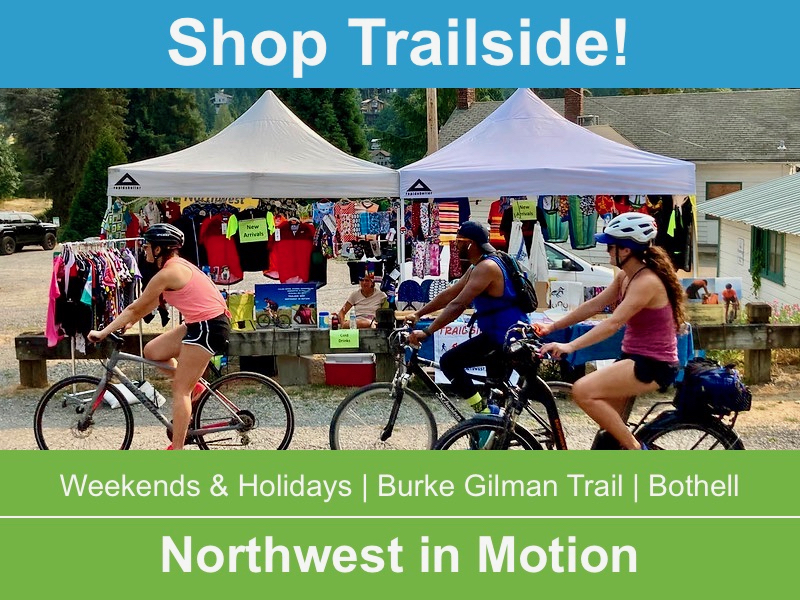Within the progression of ultra running, Ras & Kathy Vaughan are rather unlikely activists. Ras’ first backpacking trip at age 11 ended with his Boy Scout troop being rescued by helicopter. When Ras and Kathy met in 1996 neither had any formal athletic experience, and Ras in particular was doing his utmost to become a member of the obesity epidemic. Despite their improbable beginnings, and the “ordinariness” of their athletic abilities, they are at the leading edge of a niche ultra trail running discipline they call “UltraPedestrian“-ism.
The things that have made us stand out are the very things that define Human Beings, not elite athletes: stubbornness, the ability to improvise solutions to challenges as they arise, and the ability to make the mind move the body. We don’t see ourselves as exceptional athletes in any way. Kathy and I both consider ourselves to be ordinary Human Beings, and ordinary Human Beings are capable of amazing and extraordinary things!
Their relationship has been a catalyst for transformation and Ras credits Kathy for saving his life. Their individual passions inspire one another to dream up audacious new projects that now have them traveling around North America and the globe. A lean and mean Ras now sports an enviable set of dreadlocks as he rambles through the backcountry.
They are quite busy supporting others interested in UltraPedestrian adventures, as well as documenting their own. They oversee the annual UltraPedestrian Wilderness Challenge adventure blogging contest which is entering its sixth year. Ras is working with Joel Ballezza of The Wild Ones Films to put together a movie about his recent adventure in Lesotho and South Africa. He is also is putting together a limited edition photo book from his meanderings in Madagascar among the Bara people in the Southern Makay Massif. Ras & Kathy are compiling a book about their attempted yo-yo (out-and-back) of theGrand Enchantment Trail (GET), titled 98 Days Of Wind (The Greatest Fail Of Our Lives).
If trail running and ultra terminology are unfamiliar to you, check out the lexicon.
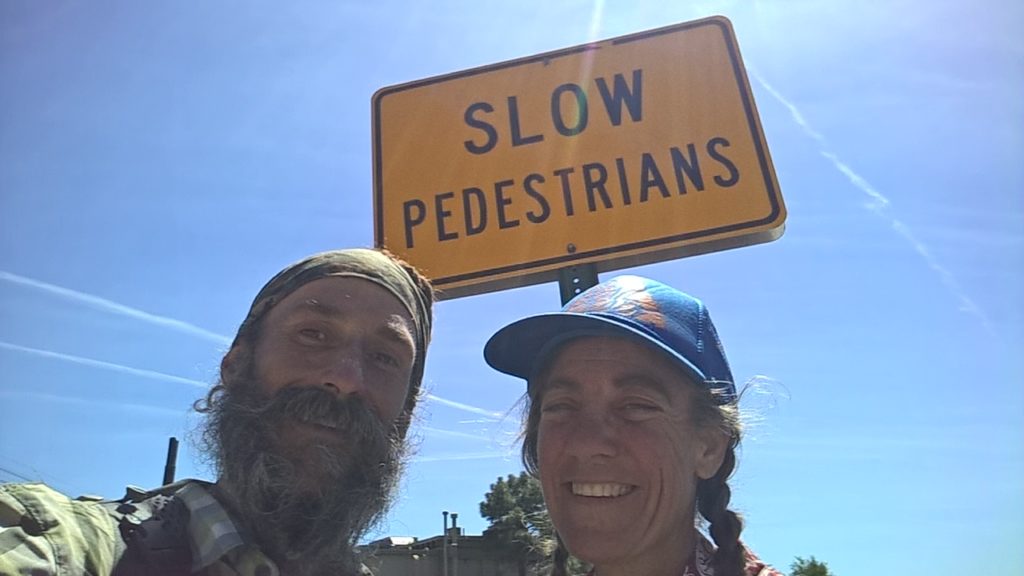
What was your life like back when you guys first met; what role did movement in the outdoors have for you?
Kathy: Before Ras and I met, I was physically active and had prioritized staying physically fit since I was a young teen. I had always enjoyed long bike rides on country roads where I grew up. This transitioned into enjoying aerobic dance, power walking, and finally finding trails and enjoying long hikes. I tried my first backpacking trip when I was 21, but I didn’t take it up whole-heartedly until Ras and I had our first 3-day trip together, 21 years ago.
Ras: I wasn’t active in any sort of athletic way at the time. I was working as a frozen food delivery driver 12-15 hours per day, 5-6 days per week. I was slightly active in that I would jog from the truck up to customers houses and back, but that wasn’t even close to enough exercise to burn off the calories I was consuming. It wasn’t uncommon for me to eat a half gallon of ice cream or an entire box of ice cream bars as I drove around covering my route. And I don’t mean a little 6 count retail box of ice cream bars, I mean an institutional size 24 count box. And that soon took its toll. Within a year of Kathy and I meeting we were married and buying a house and I suddenly had a family to provide for, so I was working as much as I could. But those 80 hour work weeks gave me the excuse I wanted to indulge in fast food, frozen food, and junk food. I felt exhausted on my one or two days off each week. All I wanted to do was sit on the couch, watch TV, and drink a two-liter bottle of RC cola while consuming a family-sized bag of Doritos. Within two years of us getting married I had ballooned to over 260 pounds.
How did you meet?
Kathy: I was in my backyard with a small group of kids when I operated a home daycare. I noticed a frozen food truck parked in the neighborhood and a tall, handsome guy running around from door-to-door, wearing bright red Chuck Taylors on his feet. It was kinda love at first sight.
Ras: I was working for a frozen food delivery company and was building up the route, knocking on doors to add on new customers. I knocked on the door of a tiny yellow house and got no answer, but heard voices from around back. I walked around the side of the house and saw Kathy standing in her little garden with the sun shining through her golden hair and children running around her feet. It was a bright, sunny day, and all of the sunshine seemed to be emanating from her. To this day, when I picture Kathy in my mind, that’s the first image of her I see. Fortunately, she bought a bag of frozen stir-fry vegetables, so I was able to add her as a new customer and stop back in a few weeks later.
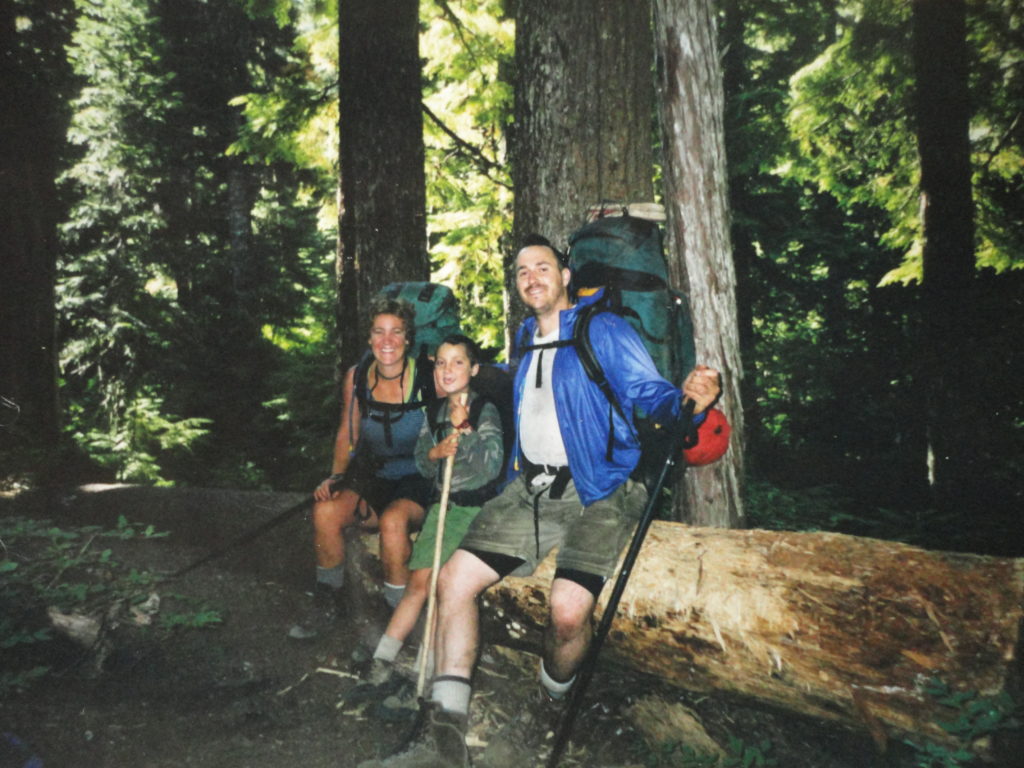
Tell us about the transformation that happened as your relationship progressed.
Kathy: I stayed healthy throughout my pregnancy, following a vegetarian diet and taking in good nutrients so the baby would be grow strong inside of me. I walked every day and my cravings were healthy ones. I remember eating a lot of fresh, juicy oranges and loving them.
I went through an unhealthy period when our daughter Angela started school and I became a busy parent. I started giving in to the easy-to-prepare frozen food. It took an illness and surgery for me to get back on track. In 2007 had a portion of my pancreas and all of my spleen removed due to a growth that had to come out. I lost weight during that time and decided to begin to avoid eggs and dairy. I also began enjoying endurance outings on my cross-country skis that winter. This transitioned into trail running in the spring. Backpacking with heavy packs for years, soon became fast packing with ultra light gear, running when the trail allowed. This has all morphed now into setting fun, challenging goals to go after – long distance hiking routes that no one has ever yo-yoed (done as an out n’back); doing a route during an off-season; hiking a long distance route with a “Feet on the Ground Ethic”, meaning hiking into all resupply spots and not hopping into a car at all during the entire hike. I like the challenge of taking it up a notch. I like that at 51, I am in the best shape of my life.
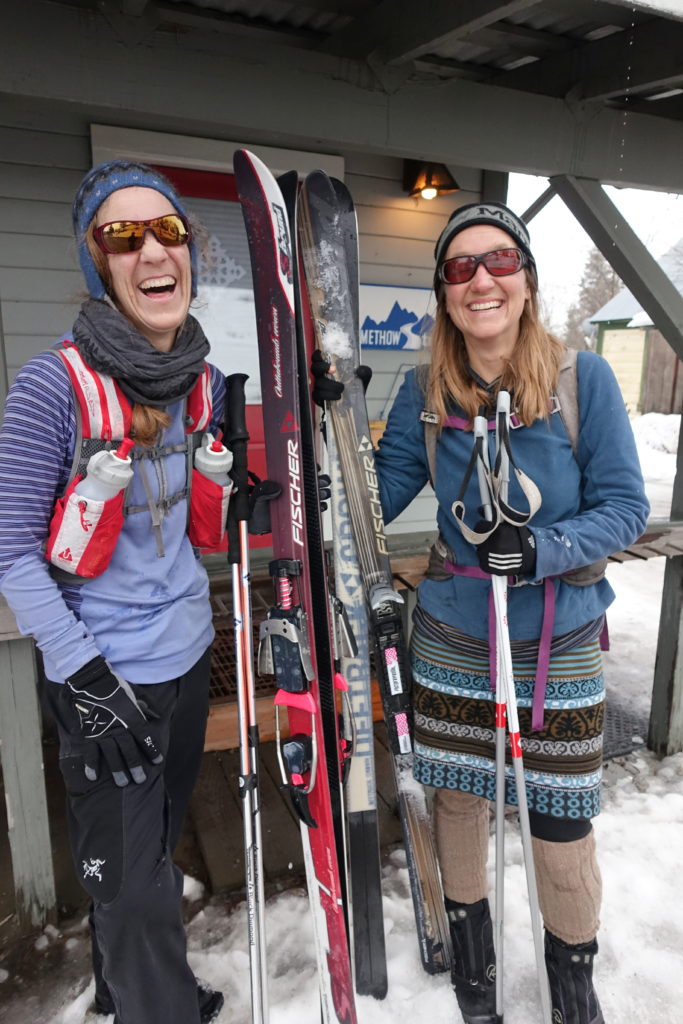
Ras: Our first Wonderland thru-hike is when I initially began to lose weight. Then I continued to lose weight while working as a merchant marine on oil tankers. I would be on a ship for months, which limited my access to food in general and junk food in particular. I couldn’t just make myself food or buy a snack whenever I wanted, so that took recreational eating off the table. Then we moved to the Okanogan Highlands in North Central Washington. We built a 12’ x 16’ cabin and lived off-grid for 7 years, with no running water, no electricity, no phone or internet, and wood heat, in addition to being 20 miles from the nearest town. Convenient junk food wasn’t available, and every aspect of life included physical work. I was putting in very long days of demanding physical labor building barbed wire fences, working construction, and cutting firewood to make ends meet. My busiest year for firewood I cut, loaded, and delivered more than 200 cords. A cord of douglas fir weighs approximately 3000 pounds (assuming it’s completely dry, which it wasn’t always), so loading a cord into the truck and then offloading it entailed physically moving a total of 6000+ pounds, and many days I did two cords. It’s incredibly difficult and time consuming to try to replicate that sort of lifestyle training in a gym. In addition to a life of hard physical labor, we also had an extremely limited budget, and in the dead of winter there was very little work available to earn money to buy food. There were times we had so little money that not only did we not have grocery money, we didn’t have gas money to drive into town. I had to hitchhike into town in zero degree temperatures to get to the foodbank to make sure we had something to eat for the following week. Essentially, we chose a lifestyle that removed us from the post-industrial consumer paradigm and made us live more like hunter-gatherers, in terms of the unreliable flow of food and the constant demand for physical exertion. We thrived.

How has your relationship has been a catalyst for transformation?
Kathy: I helped Ras to get up off the couch and become more active. He was working long hours with the frozen food company, and did not have much energy on the weekends. He was overweight from having easy access to unhealthy foods. He says that during that time, he was eating full size boxes of ice cream bars each day during his shift. I wanted him to go on hikes with me, but he didn’t want to go. When he did go, it hurt his back and he just wanted to be home eating and resting. Finally, he found the joy in being on the trails and the rewards he felt afterwards. He dove into hiking, then trail running, then ultrarunning. He convinced me that I could run ultras too. We initially spent a lot of time together on the trails skiing or backpacking with a heavy pack. He helped get me signed up for Baker Lake 50k, a fairly mellow run along the scenic lake. I completed that race and have not stopped since. Ras continues to support me in any goal I come up with, no matter how outrageous. I support him in the same way. This allows us the opportunity to pursue individual and team challenges as priorities in our lives. We know how important it is to each other.
Ras: Kathy is the one who got me up off the couch. I was literally eating myself to death, and I credit her with saving my life. She was constantly trying to get me out on the trail just for short day hikes, inviting me, encouraging me, even nagging if necessary. She wanted to be out hiking, but at the time I couldn’t walk for more than a mile without ending up bent over on the side of the trail struggling for breath and suffering debilitating lower back pain. Kathy kept up her campaign of pressuring, encouraging, and cajoling me, and I gradually became slightly more fit.
Then, in the summer of 2000, Kathy proposed the idea of the three of us as a family thru-hiking the Wonderland Trail around the base of Mount Rainier. I really don’t know why she thought we could accomplish such a thing. At the time I wasn’t sure we could, but I loved the idea of it. It was the sort of adventure that I had read about all my life, but of which I had never necessarily considered myself capable. In the end it took us 19 days to cover those difficult 93 miles; 93 miles which are commonly covered in 10 days by conventional backpackers and 3 days by ultrarunners. But that trip around Mount Rainier is what ignited the spark within us and that now drives us. We fell in love with being on the trail. Over time we realized that the trail is where we can best be our true selves and have the fullest experience of reality and our own fundamental humanity. We both enjoy taking on solo challenges and projects with other people, but moving together as a team through beautiful and challenging terrain is what captures our imagination.
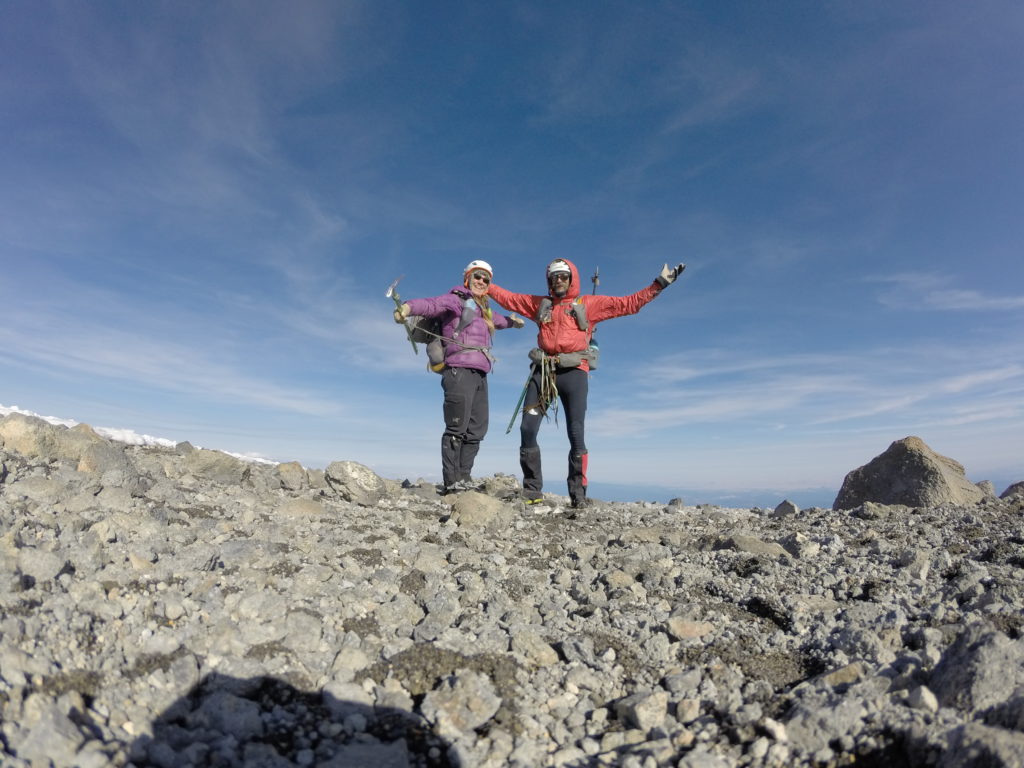
How did your diet and activity levels change over time?
Kathy: Throughout the years my activity levels have definitely increased. I never would have imagined trying to get in 40-50 mile weeks when Ras and I first met, but now I have it as a weekly goal. At that time, I was following a low fat diet, but still partaking in white meats–poultry and fish. I transitioned into a diet of vegetarianism, and now I aim to follow a vegan diet with an emphasis on low carbs and low fat, to accommodate my diabetic needs.
Ras: I’ve been a vegetarian since I was 15 years old, so I was a vegetarian even when I was fat. The two factors that made a big difference for me were changing my lifestyle so that I was physically active all day long everyday, and avoiding milk and egg products.

The connection you experience between mind, body, and environment is obviously a more important impetus for you to attempt and complete ultra challenges than say hitting a target time goal…
Kathy: I am at peace when I am on the trails, breathing in the fresh air and taking in all of the sights and sounds of my natural surroundings. I depend on these times for my mental health. I feel happier and better able to handle daily life, if I have had time in the outdoors, time pushing my mind and body to its limits on a regular basis. I love the feeling of having worked my body so hard that I collapse with exhaustion and absorb the benefits of the endorphins rushing throughout my body. My creative side comes to life and I am able to share about my adventures with others, cook & bake delicious foods from scratch, and set unique adventure goals while in this relaxed state of mind.
Ras: On the trail, moving through beautiful and challenging places, is the only time I feel fully alive and truly Human. It doesn’t matter whether I am beginning a project that I might not be able to actually to complete, well on my way to setting a personal record, or sitting exhausted on the side of the trail. Wild places are where I feel I belong. Cities make me uncomfortable. When I’m in a city I don’t know who or what people expect me to be. I feel like I’m pretending to be a responsible grown up and everyone can see right through the charade. I not only feel out of place, but I feel like my suppressed ancient Hominid self is going to rend asunder my facade of domestication. And I sense that same conflict in others: a burbling animality behind a veneer of refinement. And that calls to mind the Angel’s warning to Lot, “Flee to the mountains lest thou be consumed!” Civilization seems like such a precariously fragile illusion. It’s an amazing construct.
While the physical benefits of moving around outside are at least widely expounded, if not universally known, the psychological benefits may be even more important. Moving through natural places provides us with sensory input about our habitat, climate, and neighbors. And this input affects our brain chemistry, and brain chemistry essentially determines who we are. We are all different people, with different brain chemistry. We are more essentially and fundamentally Human when we see, smell, hear, taste and feel the World around us.
Ultradistance endurance efforts take this to another level altogether. Life becomes very simple and very clear. The muddled flood of conflicting drives and temptations that defines modern civilization melts away when you are deep in the wilderness and moving on two legs. It’s simply about how the mind moves the body, especially when the body is tired and hungry and telling you to stop. For me, those moments are times of connection with the fundamental strength of Human Beings. Each of us has a hidden reserve of strength for us to access in extreme situations. This is what enables mothers to lift cars off their children, or allows people to survive forced marches, such as the Bataan Death March or the Trail Of Tears. In modern first world societies we’ve constructed a lifestyle where we not only don’t need to access those reserves of strength, but wherein many of us have forgotten how. By losing that knowledge, that ability, we lose an important part of what makes Human Beings so successful as a species.

Talk about how you feel like “ordinary human beings.”
Kathy: I did not grow up as an athlete. I work hard to run and hike long distances. None of it comes easily or effortlessly to me. I am just an ordinary 51-year old woman, choosing to prioritize adventuring and living a healthy lifestyle. I often fall short financially, physically, and emotionally. I keep a pace that keeps me sustainably running at the back of the pack, able to put out endurance efforts year-round. I have worked since I was a young girl mostly in jobs requiring physical labor. I have reached the point in my life where I want to prioritize what keeps me happy and healthy. I am willing to put in the work to do so, just as most human beings do in their daily lives. I could be working an office job, or teaching children, or selling clothing for a living. I just choose to run and hike long distances instead, sacrificing material comfort and long term financial stability in order to do so.
Ras: A few years ago at the Gorge Waterfalls 50k I set what was then my 50k PR. I was well-trained and I pushed myself as hard as I ever have in a race. And when all was said and done, I came in exactly in the middle of the pack. So my best effort, under good conditions, one of the peak performances of my life, was mathematically average. I’m not fast, or particularly skilled even. The things that have made me stand out are the very things that define Human Beings, not elite athletes: stubbornness, the ability to improvise solutions to challenges as they arise, and the ability to make the mind move the body. We don’t see ourselves as exceptional athletes in any way. Kathy and I both consider ourselves to be ordinary Human Beings, and ordinary Human Beings are capable of amazing and extraordinary things!
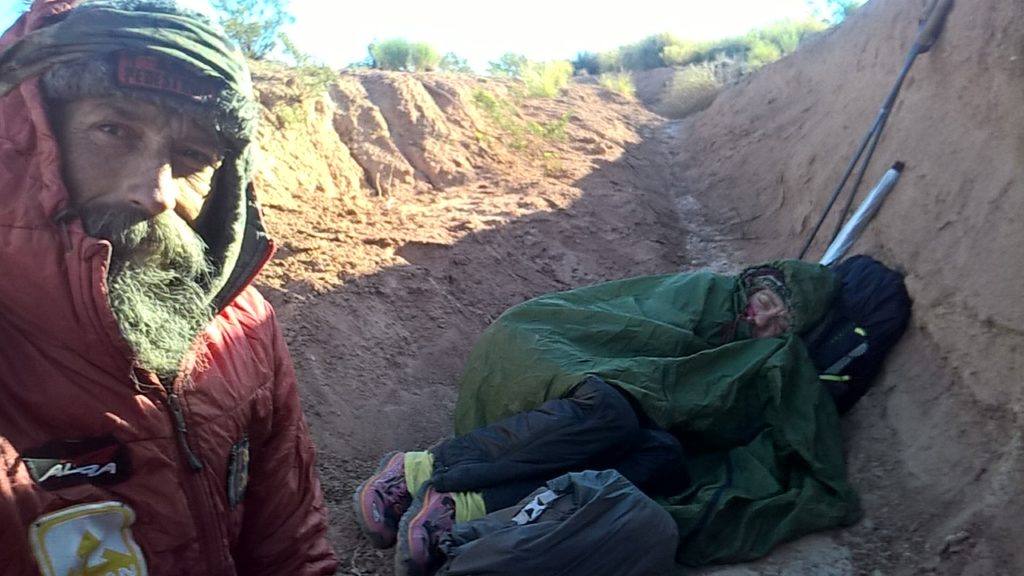
How do you see ultra progressing over time? What’s on the horizon? Who are some of the folks you think are pushing ultra further? What kinds of projects are they doing?
Kathy: Over the years, I have seen a progression from ultrarunners sticking with supported trail races, to pushing the boundaries of their comfort and hitting the trail without support. Runners and hikers are incorporating increasingly challenging ways to complete the same routes others have completed with support and guidance. Folks are pursuing projects that incorporate multi-faceted adventuring skills, such as running to a mountain to summit and then running back to their car afterwards. I like seeing trail runners that I have known going after a more challenging way to complete an endurance effort, such as a runner I’ve known who always used pacers, and is now running 200 mile races solo without crew, just to up the ante.
Ras: There has been a perfect storm of developments in recent years that have not only contributed to the increase in popularity of Only Known Time (OKT) and Fastest Known Time (FKT) attempts, but have made it the best time ever to be a an FKT player.
Advances in mapping, navigation, and tracking have not only made it easier to prove the veracity of one’s FKT and OKT projects, but have greatly expanded the playing field, as it were. Online mapping technologies such as Caltopo and Gaia Maps make it easy to design a project, download a GPS track to your navigation device (GPS or phone), and even publish the map online when you call your shot. And improvements in battery and satellite technologies will soon make it so that adventures can be posted, broadcast, and streamed live as they unfold, so that armchair adventurers and sport fans can follow them in real time.
Gear is continuing to get lighter, stronger, and be more multifunctional, making it possible to carry less weight and fewer items, which means the ability to enjoy covering more ground.
The future is wide open, with new technologies constantly being developed that could vastly change adventuring and greatly expand what is considered “humanly possible”.
Here are some of the more “out there” ideas I see happening:
Drone resupplies in which drones meet you at preplanned points with necessary food and gear, and even haul off garbage and unnecessary gear.
Food generators that contain a mass of cells similar to sourdough starter that will reproduce continuously within the device, replenishing the supply of cells after each meal is dispensed.
Packs and clothing made from solar fabric or fabric that captures the energy produced by movement, in order to power phones and GPSs.
Transdermal calorie patches that can time release calories directly into your bloodstream, eliminating the need to eat or carry food.
Who are some of the athletes pushing the limits?
Heather “Anish” Anderson is, to me, the embodiment of the modern hominid. She not only knows how to tap into the hidden reserves of strength that Human Beings have, but she also excels at the logistical aspects of planning and executing adventures on a grand scale. The end result is that even though she is hiking and covering all of her resupply mileage on foot, she puts up times on long trails that even supported runners can’t match.
Shawn “Pepper” Forry also comes immediately to mind. He seems to be fascinated with projects that redefine what people consider possible, that expand the paradigm: the first ever winter thru-hike of the Pacific Crest Trail (PCT) (with Justin “Trauma” Lichter), for example, and completing the Colorado Trail in unsupported style (which was the inspiration and motivation for my Unsupported Washington Traverse via the PCT).
Liz “Snorkel” Thomas has been spearheading the urban thru-hiking movement for five years now, in addition to her impressive achievements on the trail. Traveling a city on foot is the best way to truly experience it, plus I think the urban thru-hike idea is something cities and their tourism boards can support. Urban thru-hikers can carry very little food, if any, and buy what they need along the way, as well as staying in motels, hostels or AirBnbs, so they spend money in the city through which they are traveling. I think this could provide a lot of motivation for communities of all sorts to plan out urban thru-hike routes. It’s brilliant.
A few years ago Gavin Woody coined the term “ultraneering” to describe adventures that combine ultradistance (greater than 26.2 miles) travel with the need for a mountaineering skillset and kit. In 2016 he and I put up the first major ultraneering line when we became the first to complete Chad Kellogg’s Mount Rainier Infinity Loop. This past summer Gavin and Richard Kresser put up a very pretty ultraneering FKT of 15 hours 35 minutes car to car for the Tatoosh Traverse, totalling a little over 28 miles and 12,000 feet of elevation gain.
In addition to the Tatoosh Traverse, in 2016 Richard Kresser completed an incredibly impressive Only Known Time project that he called Dick’s RASH. Check out the Dick’s RASH video. He summited and circumnavigated Mts Rainier, Adams, St. Helens, and Hood within 156 hours. He used a vehicle for travel between the mountains, but I know he has future plans for exclusively human-powered projects.
What future projects look personally exciting to you?
Kathy: I am looking forward to tackling some more long-distance thru hikes, specifically in the deserts, such as the Hayduke Trail and the Oregon Desert Trail. I am also wanting to pursue more 100 and 200 mile supported race distances, in order to better connect with the ultrarunning community and test myself in timed events. I love the idea of also pursuing these distances unsupported, depending on myself to provide everything I will need to complete the distance, and probably taking more time than in the supported events.
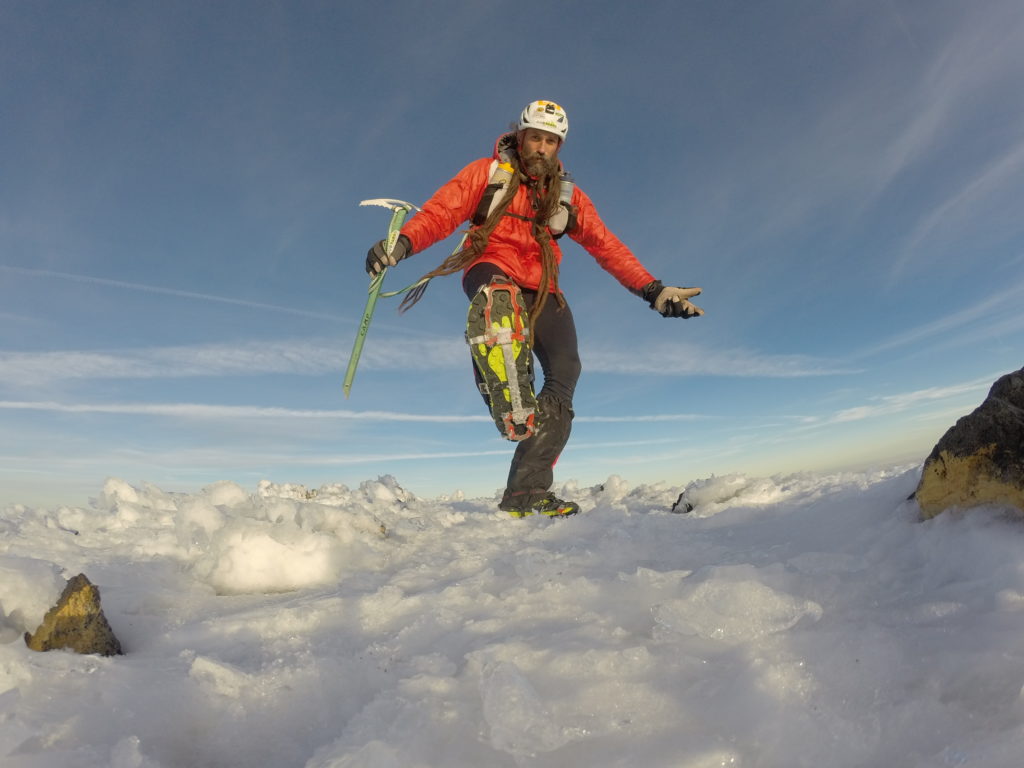
Ras: I’d like to apply the Infinity Loop approach to more mountains. It’s a fascinating way to have a really unique experience of a mountain.
In 2018 Kathy and I plan to link together the Pacific Northwest Trail, Idaho Centennial Trail, Oregon Desert Trail, and Pacific Crest Trail into a 3,000ish mile Pacific Northwest Loop. In 2019 we’re hoping to attempt the Golden Volcanoes Challenge, which entails summiting all 11 of the Cascade volcanoes over 10,000 feet in elevation and linking them all together on foot.
Ras and Kathy’s adventures are made possible through the support of:
Altra Running
Gossamer Gear
Nathan Sports
Trail Butter
Seven Hills Running Shop
